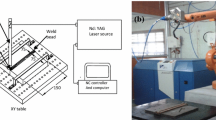Abstract
Laser beam welding of dissimilar ferritic/martensitic stainless steels was performed in constrained butt joint configuration with the objective of identifying the influence of the melting ratio between the two base metals on the ultimate shear strength of the welds. Based on a full factorial design, experiments demonstrated that varying the incidence angle up to 45° and offsetting the focal position with respect to the materials’ interface within the limits imposed by the laser spot diameter are a reliable method to control the melting ratio and maintaining the expected resistance length at the material interface. The weld configuration parameters were correlated by means of the analysis of variance (ANOVA) method with shear resistance length and the melting ratio: the incidence of surface cracks can be significantly reduced increasing the ferritic steel area, involved in the formation of seam, over 60 % of the whole melt zone. Push-out tests performed on the specimens revealed that such a configuration has beneficial aspects on the ultimate shear strength of the seam meaning that the prevailing effect is the decreased brittleness of the weld by decreasing its carbon content under 0.5 % in weight.
Similar content being viewed by others
References
Messler WRJ (2004) Joining of metals, alloys, and intermetallics. Joi Mater Struct pp. 535–582
Wenyong W, Shengsun H, Shen J (2015) Microstructure, mechanical properties and corrosion behavior of laser welded dissimilar joints between ferritic stainless steel and carbon steel. Mater Des 65:855–861
Phanikumar G, Manjini S, Dutta P, Mazumder J, Chattopadhyay K (2005) Characterization of a continuous CO2 laser-welded Fe-Cu dissimilar couple. Metall Mater Trans A 36A:2137–2147
Sun Z, Ion JC (1995) Laser welding of dissimilar metal combinations. J Mater Sci 30:4205–4214
Duley WW (1999) Laser welding. Wiley, New York
Vaidya WV, Horstmann M, Ventzke V, Petrovski B, Kocak M, Kocik R, Tempus G (2010) Improving interfacial properties of a laser beam welded dissimilar joint of aluminium AA6056 and titanium Ti6Al4V for aeronautical applications. J Mater Sci 45:6242–6254
Chen L, Zhou L, Tang C, Huang W, Wang C, Hu X, Wang J, Yan F, Wang X, Jiang Z, Shao X (2014) Study of laser butt welding of SUS301L stainless steel and welding joint analysis. Int J Adv Manuf Technol 73:1695–1704
Caiazzo F, Alfieri V, Sergi V, Schipani A, Cinque S (2013) Dissimilar autogenous disk-laser welding of Haynes 188 and Inconel 718 superalloys for aerospace applications. Int J Adv Manuf Technol 68:1809–1820
Gao M, Wang ZM, Li XY, Zeng XY (2012) Laser keyhole welding of dissimilar Ti-6Al-4V titanium alloy to AZ31B magnesium alloy. Metall Mater Trans A 43A:163–172
Berretta JR, de Rossi W, Neves MDM, de Almeida IA, Junior NDV (2007) Pulsed Nd:YAG laser welding of AISI 304 to AISI 420 stainless steels. Opt Lasers Eng 45:960–966
Liao YC, Yu MH (2007) Effects of laser beam energy and incident angle on the pulse laser welding of stainless steel thin sheet. J Mater Process Technol 190:102–108
Benyounis KY, Olabi AG (2008) Optimization of different welding processes using statistical and numerical approaches—a reference guide. Adv Eng Softw 39:483–96
Anawa EM, Olabi AG (2008) Optimization of tensile strength of ferritic/austenitic laser-welded components. Opt Lasers Eng 46:571–577
Ruggiero A, Tricarico L, Olabi LG, Benyounis KY (2011) Weld-bead profile and costs optimisation of the CO2 dissimilar laser welding process of low carbon steel and austenitic steel AISI316. Opt Laser Technol 43:82–90
Khan MMA, Romoli L, Fiaschi M, Dini G, Sarri F (2012) Multiresponse optimization of laser welding of stainless steels in a constrained fillet joint configuration using RSM. Int J Adv Manuf Technol 62:587–603
Marashi P, Pouranvari M, Amirabdollahian S, Abedi A, Goodarzi M (2008) Microstructure and failure behavior of dissimilar resistance spot welds between low carbon galvanized and austenitic stainless steels. Mater Sci Eng A 480:175–180
Torkamany MJ, Sabbaghzadeh J, Hamedi MJ (2012) Effect of laser welding mode on the microstructure and mechanical performance of dissimilar laser spot welds between low carbon and austenitic stainless steels. Mater Des 34:666–672
Rossini M, Russo Spena P, Cortese L, Matteis P, Firrao D (2015) Investigation on dissimilar laser welding of advanced high strength steel sheets for the automotive industry. Mater Sci Eng A 628:288–296
Baghjari SH, AkbariMousavi SAA (2014) Experimental investigation on dissimilar pulsed Nd:YAG laser welding of AISI 420 stainless steel to kovar alloy. Mater Des 57:128–134
Franco A, Romoli L, Musacchio A (2014) Modelling for predicting seam geometry in laser beam welding of stainless steel. Int J Therm Sci 79:194–205
ISO 13919-1:1996 Welding—electron and laser-beam welded joints—guidance on quality levels for imperfections—part 1: steel (reviewed in 2011).
Serizawa H, Mori D, Shirai Y, Ogiwara H, Mori H (2013) Weldability of dissimilar joint between F82H and SUS316L under fiber laser welding. Fusion Eng Des 88(9-10):2466–2470
Rai R, Elmer JW, Palmer TA, DebRoy T (2007) Heat transfer and fluid flow during keyhole mode laser welding of tantalum, Ti–6Al–4V, 304L stainless steel and vanadium. J Phys D Appl Phys 40:5753–5766
Zulkali MMD, Ahmad AL, Norulakmal NH (2006) Oryza sativa L. husk as heavy metal adsorbent: optimization with lead as model solution. Bioresour Technol 97:21–25
Khan MMA, Romoli L, Fiaschi M, Dini G, Sarri F (2012) Laser beam welding of dissimilar stainless steels in a fillet joint configuration. J Mater Proc Technol 212:856–867
Author information
Authors and Affiliations
Corresponding author
Rights and permissions
About this article
Cite this article
Romoli, L., Rashed, C.A.A. The influence of laser welding configuration on the properties of dissimilar stainless steel welds. Int J Adv Manuf Technol 81, 563–576 (2015). https://doi.org/10.1007/s00170-015-7234-8
Received:
Accepted:
Published:
Issue Date:
DOI: https://doi.org/10.1007/s00170-015-7234-8



